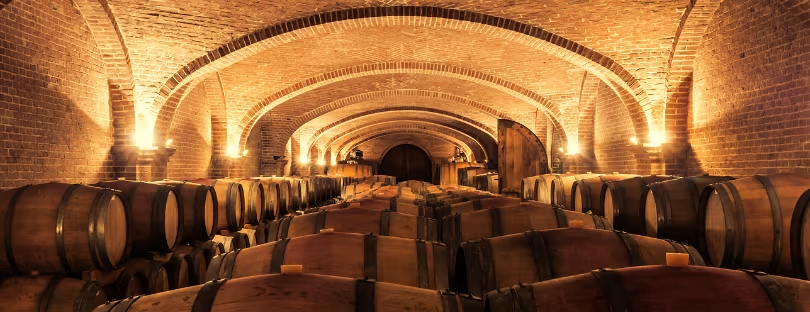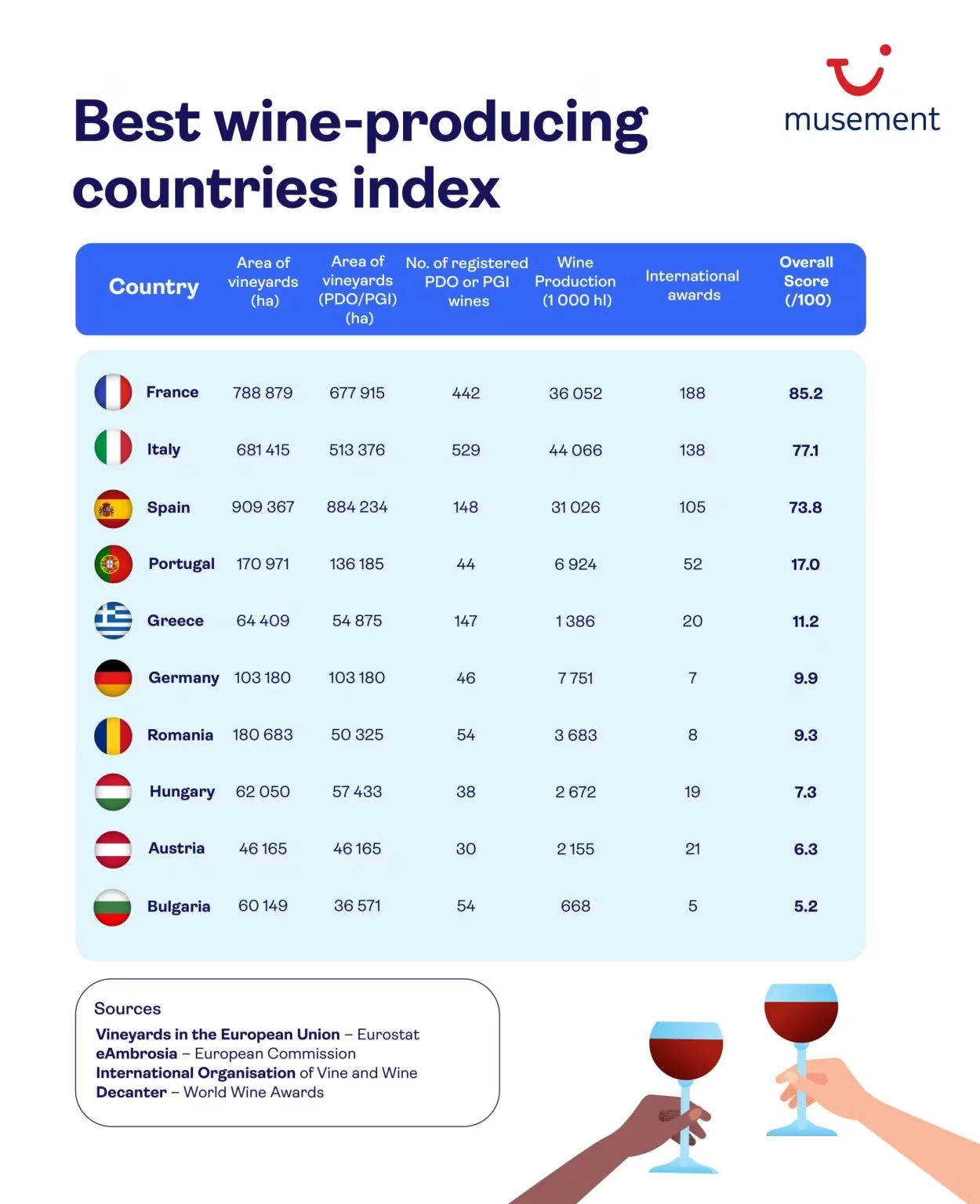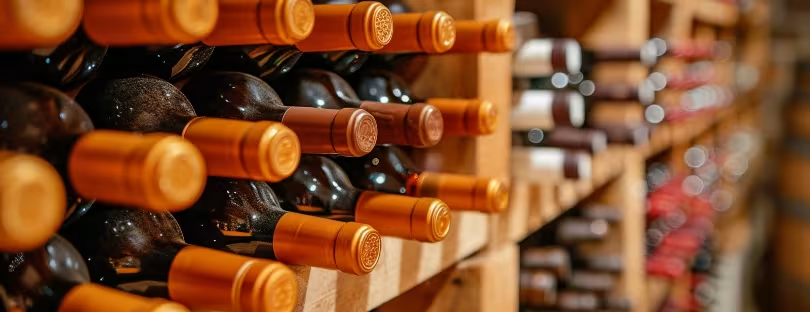
Europe’s Top 10 Wine Tourism Destinations: From France to Greece and Beyond
When people think of wine tourism, the same names pop up again and again — France’s Bordeaux and Burgundy, Italy’s Tuscany and Piedmont, Spain’s Rioja and Ribera del Duero. And yes, these places deserve their fame. They’re beautiful, historic, and home to some of the best bottles you’ll ever taste. But here’s the thing: Europe’s wine map is far richer than the “big three.” European wine tourism
A new study from TUI Musement, the European Wine Tourism Index, has ranked destinations across the continent. While France, Italy, and Spain still take the crown, the next five spots are fascinating. They’re countries where wine has been part of culture for centuries, but their tourism potential hasn’t always been front and center. That’s starting to change — and fast.
What is the Index?
TUI Musement has created a comparative ranking of European countries to see which ones are most “attractive” for wine tourism. Rather than being purely opinion or survey-based, it combines hard data and travel interest.
Key features:
- All EU member states with at least 500 hectares of vineyard area were considered.
- Five main categories (metrics) are used to rank countries.
- The data sources are official / industry sources: Eurostat, the International Organisation of Vine and Wine (OIV), EU PDO/PGI registries, and results from the Decanter World Wine Awards 2025.
 How the Ranking Was Built: The Metrics & Weights
How the Ranking Was Built: The Metrics & Weights
To get from raw data to a score, TUI Musement uses five indicators, each with its own weight. Here are the categories and what they measure:
| Metric | What it measures | Weight in overall score |
|---|---|---|
| Total vineyard surface area | How many hectares are under vine in the country overall | 20% |
| Vineyard area for PDO/PGI wines | Share of vine area dedicated to protected, quality-designated wines (PDO = Protected Designation of Origin; PGI = Protected Geographical Indication) | 30% |
| Number of registered PDO/PGI wines | Count of distinct wines under those quality labels in the registry | 20% |
| Wine production volume (latest data) | How much wine is produced — a volume measure that hints at scale of industry | 10% |
| International awards received | Recognition / quality as judged in global competitions (here e.g. Decanter World Wine Awards) | 20% |
The weighting shows what’s valued most: quality designations (PDO/PGI) are especially important, followed by registered variety (diversity) and international prestige via awards. Production volume counts, but less heavily than “quality / reputation” metrics.
Top 5 Countries & Highlights
Here are the countries that came out on top, and what makes them stand out.
1. France
France is number one because it has everything: world-famous regions (Bordeaux, Burgundy, Champagne), UNESCO-listed vineyards, and the largest haul of international wine awards. The country has turned wine tourism into a polished industry — from luxurious château tastings to village wine routes. Add the fact that wine tourism here generates billions each year, and France’s dominance makes sense.
2. Italy
Italy stands out thanks to its sheer variety. It has the most PDO/PGI wine designations in Europe, covering everything from Tuscany’s Chianti to Piedmont’s Barolo and Veneto’s Prosecco. What makes Italy “good” is the full package: breathtaking landscapes, food culture that pairs perfectly with the wines, and a sense of lifestyle that travellers want to be part of.
3. Spain
Spain’s strength lies in its scale and diversity. With Europe’s largest vineyard area — and nearly all of it under PDO/PGI quality labels — Spain delivers consistency and choice. You can sip bold reds in Rioja, sherry in Andalusia, or discover volcanic wines in the Canary Islands. Spain is also good at combining tradition with innovation, making wine tourism fresh and accessible.
4. Portugal
Portugal punches well above its weight. The Douro Valley is one of the most beautiful vineyard landscapes in the world, and its river cruises make wine tourism an immersive experience. Portugal’s global brand, Port, gives it recognition far beyond its size, while regions like Alentejo and Dão are steadily building reputations for high-quality wines. What makes Portugal strong is how compact yet diverse it is — you can experience a lot in a short trip.
5. Greece
Greece brings something unique to the table: a blend of ancient history and striking landscapes. Its native grape varieties (Assyrtiko, Agiorgitiko, Xinomavro) give wines you can’t easily find elsewhere. Vineyards on volcanic islands like Santorini or in the mountains of Crete aren’t just places to taste wine, they’re destinations in themselves. Greece is good because it doesn’t separate wine from culture — it’s all part of the same story of mythology, cuisine, and hospitality.
Beyond the top 5, the index identifies Germany (6th), Romania (7th), Hungary (8th), Austria (9th), Bulgaria (10th) as “emerging wine tourism destinations.” Each offers unique attractions: Rieslings in Germany; Romania’s strong reds; Tokaj in Hungary; Wachau in Austria, etc.
Top 5 emerging markets
6. Germany
Germany might be better known for beer, but wine is quietly stealing the spotlight. Think Rieslings — crisp, aromatic, and grown on steep slopes overlooking rivers like the Mosel and Rhine. What makes Germany special is the scenery: winding river valleys, medieval castles perched above vineyards, and villages that look like they belong in a fairy tale.
Wine tourism here blends tasting with storytelling. Visit in autumn, and you’ll likely end up at a local Weinfest (wine festival) where the whole town gathers. For travellers who love culture, history, and a touch of romance with their glass, Germany is an underrated gem.
7. Romania
Romania isn’t the first place most travellers think of when planning a wine trip, but it probably should be. The country has over 200,000 hectares of vineyards and a winemaking history stretching back to the Dacians. Regions like Dealu Mare produce bold reds that can stand shoulder to shoulder with more famous European varieties.
What’s exciting is how much of this feels undiscovered. Wineries here are opening their doors to visitors, blending traditional cellar tours with modern tasting rooms. If you’re into off-the-beaten-path experiences and wines you won’t easily find back home, Romania is a great bet.
8. Hungary
Hungary has one trump card that most wine countries can only dream of: Tokaj. This UNESCO World Heritage wine region produces legendary sweet wines that kings and queens once demanded at their courts. But Hungary isn’t just Tokaj. Regions like Eger (home of “Bull’s Blood” reds) and Balaton (crisp whites by the lake) make the country’s offering diverse and travel-friendly.
Wine tourism here is steeped in tradition. Many cellars are centuries old, carved into volcanic rock, yet the experience feels alive and fresh. Add Budapest — one of Europe’s most vibrant capitals — as your gateway, and Hungary becomes an irresistible destination for wine travellers.
9. Austria
Austria has quietly become a darling of sommeliers worldwide, thanks to Grüner Veltliner, its crisp, food-friendly white wine. But tasting it in Vienna or in the Wachau Valley — a stunning stretch along the Danube dotted with terraced vineyards and baroque towns — makes it unforgettable.
What Austria does brilliantly is combining wine with lifestyle. You can cycle through vineyards, stop at family-run taverns (Heuriger), and sip fresh local wines with homemade bread and spreads. It’s wine tourism that feels effortless — elegant, scenic, and authentically local.
10. Bulgaria
Bulgaria might be the biggest surprise in the top ten. The country has one of Europe’s oldest winemaking traditions, dating back to Thracian times, yet it’s rarely included in mainstream wine travel itineraries. That’s starting to shift, as regions like Thrace and the Danube Plain gain recognition.
Expect robust reds, hospitable wineries, and a sense that you’ve discovered something special before everyone else. Wine here is more than just a drink — it’s tied to folklore, music, and a deep cultural identity. For adventurous travellers, Bulgaria offers authenticity in spades.
Why These Countries Matter Now
TUI Musement’s index weighs vineyard area, quality designations (PDO/PGI), awards, and production. But the real story is how these destinations are finally stepping into the spotlight. They combine heritage, quality, and scenic beauty — all while offering something different from the classic wine routes that many travellers already know.
For visitors, this means new flavors, new landscapes, and fewer crowds. For the countries themselves, it’s a chance to boost rural economies, showcase culture, and tell their stories to the world.
Final Sip
France, Italy, and Spain may dominate the headlines, but Europe’s wine tourism future is looking much broader — and more exciting. Germany, Romania, Hungary, Austria, and Bulgaria are writing the next chapter. If you’re looking for a fresh twist on your wine travels, these emerging stars are more than ready to pour you a glass.





 How the Ranking Was Built: The Metrics & Weights
How the Ranking Was Built: The Metrics & Weights






